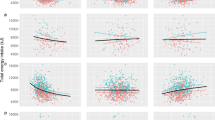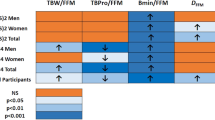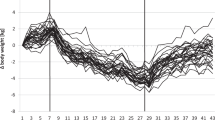Abstract
Background:
In contrast to the physiological expectation, observational studies show that greater protein intake is associated with subsequent body weight (BW) gain. An increase in fat-free mass (FFM) due to the anabolic effects of protein could explain this.
Objective:
To examine associations between protein intake and subsequent changes in fat mass (FM) and FFM in longitudinal, observational data.
Design:
A health examination, including measures of FM and FFM by bioelectrical impedance at baseline and follow-up 6 years later, was conducted. Diet history interviews (DHI) were performed, and 24-h urinary nitrogen collection at baseline was done. In total, 330 participants with DHI, of whom 227 had validated and complete 24-h urine collection data, were analyzed. Macronutrient energy substitution models were used.
Results:
Mean estimated protein intake was 14.6 E% from DHI and 11.3 E% from urinary nitrogen. Estimated from DHI, FM increased 46 g per year, with every 1 E% protein substituted for fat (95% confidence interval (CI)=13, 79; P=0.006), and FFM increased 15 g per year (1, 30; P=0.046). Results were similar in other substitution models. Estimated from urinary nitrogen, FM increased 53 g per year, with 1 E% protein substituted for other macronutrients (24, 81; P<0.0005), and FFM increased 18 g per year (6, 31; P=0.004).
Conclusion:
Within a habitual range, a greater protein intake was associated with BW gain, mostly in FM. This is in contrast to the expectations based on physiological and clinical trials, and calls for a better understanding of how habitual dietary protein influences long-term energy balance, versus how greater changes in dietary proteins may influence short-term energy balance.
This is a preview of subscription content, access via your institution
Access options
Subscribe to this journal
Receive 12 print issues and online access
$259.00 per year
only $21.58 per issue
Buy this article
- Purchase on Springer Link
- Instant access to full article PDF
Prices may be subject to local taxes which are calculated during checkout


Similar content being viewed by others
References
Halton TL, Hu FB . The effects of high protein diets on thermogenesis, satiety and weight loss: a critical review. J Am Coll NutrJ Am Coll NutrJ Am Coll Nutr 2004; 23: 373–385.
Abete I, Astrup A, Martínez JA, Thorsdottir I, Zulet MA . Obesity and the metabolic syndrome: role of different dietary macronutrient distribution patterns and specific nutritional components on weight loss and maintenance. Nutr RevNutr Rev 2010; 68: 214–231.
Paddon-Jones D, Westman E, Mattes RD, Wolfe RR, Astrup A, Westerterp-Plantenga M . Protein, weight management, and satiety. Am J Clin Nutr 2008; 87: 1558S–1561SS.
Westerterp-Plantenga MS, Nieuwenhuizen A, Tomé D, Soenen S, Westerterp KR . Dietary protein, weight loss, and weight maintenance. Annu Rev Nutr 2009; 29: 21–41.
Due A, Toubro S, Skov AR, Astrup A . Effect of normal-fat diets, either medium or high in protein, on body weight in overweight subjects: a randomised 1-year trial. Int J Obes Relat Metab Disord 2004; 28: 1283–1290.
Mcauley KA, Smith KJ, Taylor RW, McLay RT, Williams SM, Mann JI . Long-term effects of popular dietary approaches on weight loss and features of insulin resistance. Int J Obes (Lond) 2006; 30: 342–349.
Vergnaud AC, Norat T, Mouw T, Romaguera D, May AM, Bueno-De-Mesquita HB et al. Macronutrient composition of the diet and prospective weight change in participants of the EPIC-PANACEA Study. PLoS One 2013; 8: e57300.
Halkjaer J, Olsen A, Overvad K, Jakobsen MU, Boeing H, Buijsse B et al. Intake of total, animal and plant protein and subsequent changes in weight or waist circumference in European men and women: the Diogenes project. Int J Obes (Lond) 2011; 35: 1104–1113.
Astrup A, Clifton P, Layman DK, Mattes RD, Westerterp-Plantenga MS . Meat intake's influence on body fatness cannot be assessed without measurement of body fat. Am J Clin Nutr 2010; 92: 1274–1275.
Heitmann BL, Garby L . Composition (lean and fat tissue) of weight changes in adult Danes. Am J Clin Nutr 2002; 75: 840–847.
Heitmann BL, Lissner L . Dietary underreporting by obese individuals—is it specific or non-specific? BMJ 1995; 311: 986–989.
Black AE, Goldberg GR, Jebb SA, Livingstone MBE, Cole TJ, Prentice AM . Critical-evaluation of energy-intake data using fundamental principles of energy physiology.2. evaluating the results of published surveys. Eur J Clin Nutr 1991; 45: 583–599.
Isaksson B . Urinary nitrogen output as a validity test in dietary surveys. Am J Clin Nutr 1980; 33: 4–5.
Garby L, Garrow JS, Jorgensen B, Lammert O, Madsen K, Sorensen P et al. Relation between energy expenditure and body composition in man: specific energy expenditure in vivo of fat and fat-free tissue. Eur J Clin Nutr 1988; 42: 301–305.
Heitmann BL . Prediction of body water and fat in adult Danes from measurement of electrical impedance. A validation study. Int J Obes 1990; 14: 789–802.
Heitmann BL, Hills AP, Frederiksen P, Ward LC . Obesity, leanness, and mortality: effect modification by physical activity in men and women. Obesity 2009; 17: 136–142.
Cook DR . Detection of influential observation in linear regression. Technometrics 1977; 19: 15–18.
Larsen TM, Dalskov SM, van Baak M, Jebb SA, Papadaki A, Pfeiffer AFH et al. Diets with high or low protein content and glycemic index for weight-loss maintenance. N Engl J Med 2010; 363: 2102–2113.
Long SJ, Jeffcoat AR, Millward DJ . Effect of habitual dietary-protein intake on appetite and satiety. Appetite 2000; 35: 79–88.
Bosse JD, Dixon BM . Dietary protein in weight management: a review proposing protein spread and change theories. Nutr Metab (Lond) 2012; 9: 81.
Michaelsen KF, Greer FR . Protein needs early in life and long-term health. Am J Clin Nutr 2014; 99: 718S–722S.
Böhm A, Heitmann BL . The use of bioelectrical impedance analysis for body composition in epidemiological studies. Eur J Clin Nutr 2013; 67 (Suppl 1): S79–S85.
Heitmann BL . Impedance: a valid method in assessment of body composition? Eur J Clin Nutr 1994; 48: 228–240.
Iqbal SI, Helge JW, Heitmann BL . Do energy density and dietary fiber influence subsequent 5-year weight changes in adult men and women? Obesity (Silver Spring) 2006; 14: 106–114.
Westerterp-Plantenga MS, Lemmens SG, Westerterp KR . Dietary protein—its role in satiety, energetics, weight loss and health. Br J Nutr 2012; 108 (Suppl 2): S105–S112.
Bingham SA . Urine nitrogen as a biomarker for the validation of dietary protein intake. J Nutr 2003; 133 (Suppl 3): 921S–924S.
Willett W . Biochemical indicators of dietary intake. Nutritional Epidemiology, 3rd edn. Oxford University Press: New York, NY, USA, 2013, p 152.
Sammel MD, Grisso JA, Freeman EW, Hollander L, Liu L, Liu S et al. Weight gain among women in the late reproductive years. Fam Pract 2003; 20: 401–409.
Colditz GA, Willett WC, Stampfer MJ, London SJ, Segal MR, Speizer FE . Patterns of weight change and their relation to diet in a cohort of healthy women. Am J Clin Nutr 1990; 51: 1100–1105.
Acknowledgements
This work is carried out as a part of the research program of Gene-diet interactions in obesity (GENDINOB). GENDINOB is supported by the Danish Council for Strategic Research (Grant 09-067111). We thank Kim Fleischer Michaelsen for discussions about protein intake and growth in infants.
Author Contributions
AA, TIAS conceived the study. BLH designed the data collection on diet intake and body composition. MZA, KG, LÄ, AA, BLH, TIAS planned the analyses. MZA, KG, LÄ conducted the analyses. MZA, KG, LÄ, AA, BLH, TIAS interpreted the results of the analyses. MZA, KG drafted the manuscript. MZA, KG, LÄ, AA, BLH, TIAS revised the manuscript. All authors read and approved the final manuscript.
Author information
Authors and Affiliations
Corresponding author
Ethics declarations
Competing interests
AA is currently the member of external scientific advisory boards for Global Dairy Platform and MacDonald’s (both USA), and is PI of research projects funded by the Global Dairy Platform, the Danish Dairy Research Foundation and by the Arla Foods A/S, Denmark. AA has received a sponsorship of congress attendance, and a honorarium for speaking at an industry-sponsored satellite symposia from the National Cattlemen’s Beef Association, USA and Danone Inc, Europe. The remaining authors declare no conflict of interest.
Additional information
Supplementary Information accompanies this paper on International Journal of Obesity website
Supplementary information
Rights and permissions
About this article
Cite this article
Ankarfeldt, M., Gottliebsen, K., Ängquist, L. et al. Dietary protein and urinary nitrogen in relation to 6-year changes in fat mass and fat-free mass. Int J Obes 39, 162–168 (2015). https://doi.org/10.1038/ijo.2014.80
Received:
Revised:
Accepted:
Published:
Issue Date:
DOI: https://doi.org/10.1038/ijo.2014.80
This article is cited by
-
Interaction between the genetic risk score and dietary protein intake on cardiometabolic traits in Southeast Asian
Genes & Nutrition (2020)
-
Main nutrient patterns are associated with prospective weight change in adults from 10 European countries
European Journal of Nutrition (2016)
-
Isocaloric substitution of carbohydrates with protein: the association with weight change and mortality among patients with type 2 diabetes
Cardiovascular Diabetology (2015)



